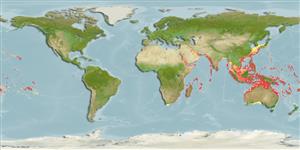Common names from other countries
Environment: milieu / climate zone / depth range / distribution range
Ecología
marino asociado a arrecife; rango de profundidad 0 - 135 m (Ref. 89972), usually 1 - 12 m (Ref. 90102). Tropical; 38°N - 36°S, 19°E - 124°W
Indo-Pacific: Red Sea and East Africa to the Hawaiian, Marquesan and Ducie islands, north to the Ryukyu and Ogasawara islands, south to the Great Barrier Reef, Lord Howe, and Rapa.
Tamaño / Peso / Age
Maturity: Lm ? range ? - ? cm
Max length : 32.0 cm SL macho / no sexado; (Ref. 1602)
Espinas dorsales (total) : 0; Radios blandos dorsales (total) : 11 - 12; Espinas anales: 0; Radios blandos anales: 9 - 10. Posterior part of body with blackish blotches; dorsal, caudal and pelvic fins with dark traverse bands (Ref. 11228).
Inhabits sand and silty reefs (Ref. 58652). Benthic (Ref. 58302). Common in shallow lagoons, reef flats, and sheltered seaward reefs. Feeds on fishes and ocacionally on crustaceans (Ref. 89972). Active at night (Ref. 5213). Caught with artisanal gear. Solitary (Ref 90102).
Life cycle and mating behavior
Maturities | Reproducción | Spawnings | Egg(s) | Fecundities | Larva
Cressey, R.F., 1986. Synodontidae. p. 270-273. In M.M. Smith and P.C. Heemstra (eds.) Smiths' sea fishes. Springer-Verlag, Berlin. (Ref. 4055)
IUCN Red List Status (Ref. 130435)
CITES (Ref. 128078)
Not Evaluated
Threat to humans
Harmless
Human uses
Pesquerías: comercial
Herramientas
Special reports
Download XML
Fuentes de Internet
Estimates based on models
Preferred temperature (Ref.
115969): 24 - 29, mean 28 (based on 2080 cells).
Phylogenetic diversity index (Ref.
82804): PD
50 = 0.5000 [Uniqueness, from 0.5 = low to 2.0 = high].
Bayesian length-weight: a=0.00724 (0.00487 - 0.01078), b=3.12 (3.00 - 3.24), in cm Total Length, based on LWR estimates for this species & Genus-body shape (Ref.
93245).
Nivel trófico (Ref.
69278): 4.2 ±0.4 se; based on diet studies.
Resiliencia (Ref.
120179): Alto, población duplicada en un tiempo mínimo inferior a 15 meses (Preliminary K or Fecundity.).
Fishing Vulnerability (Ref.
59153): Low to moderate vulnerability (29 of 100).
